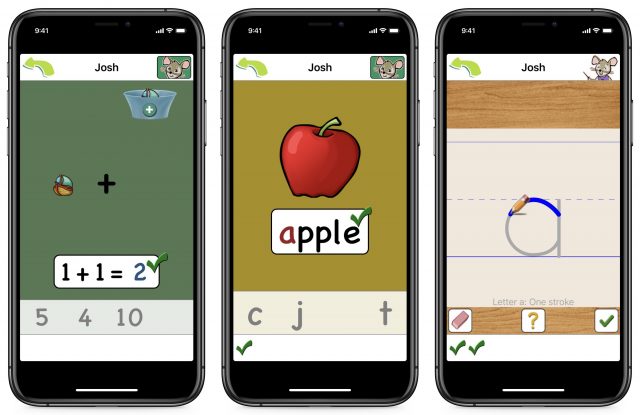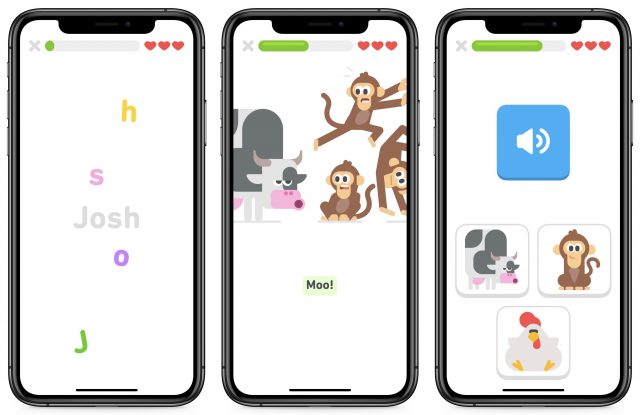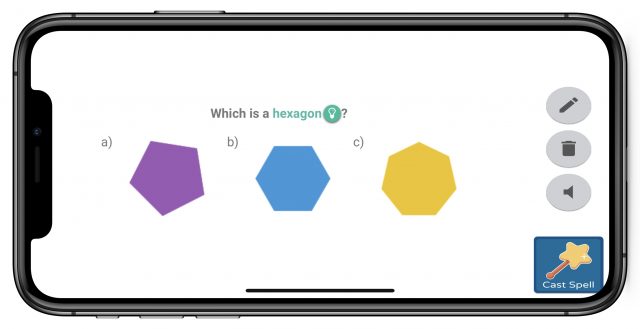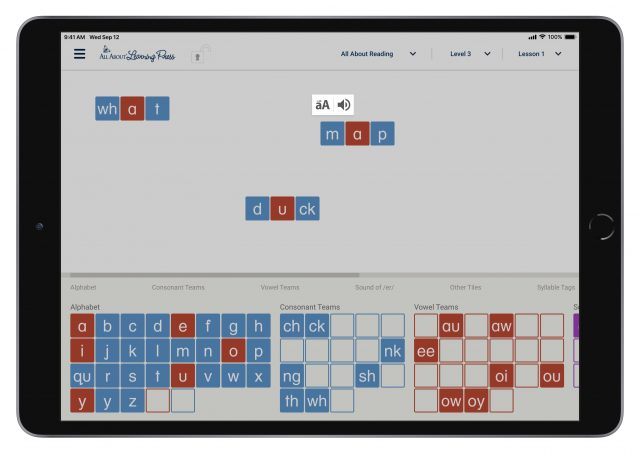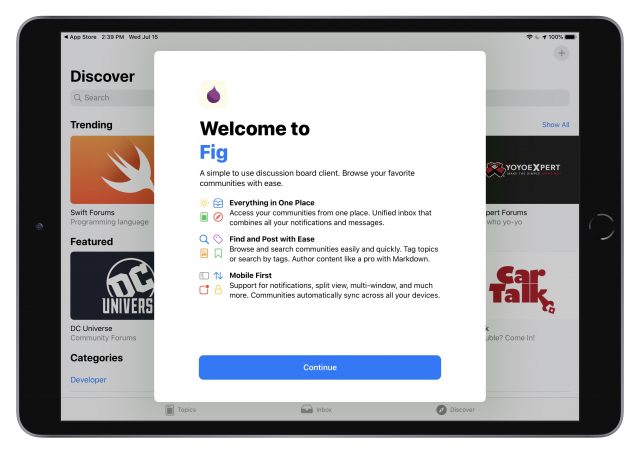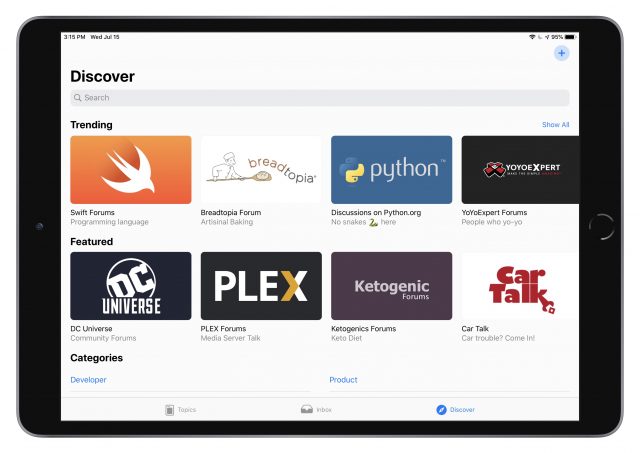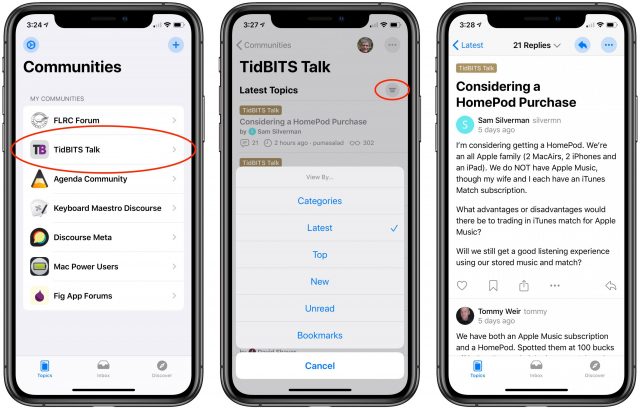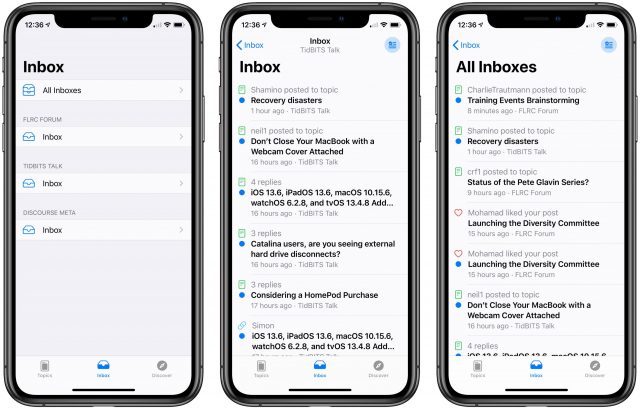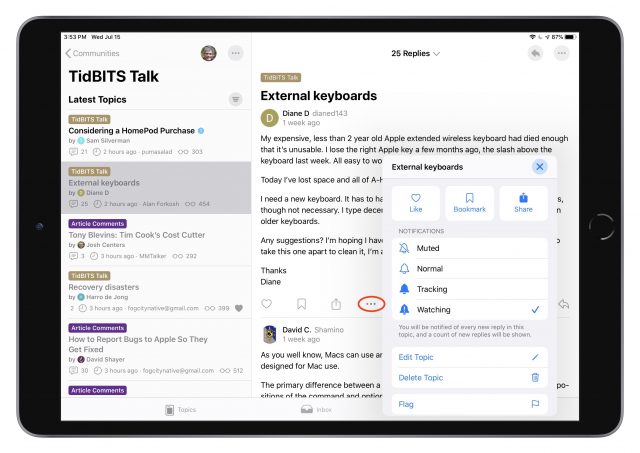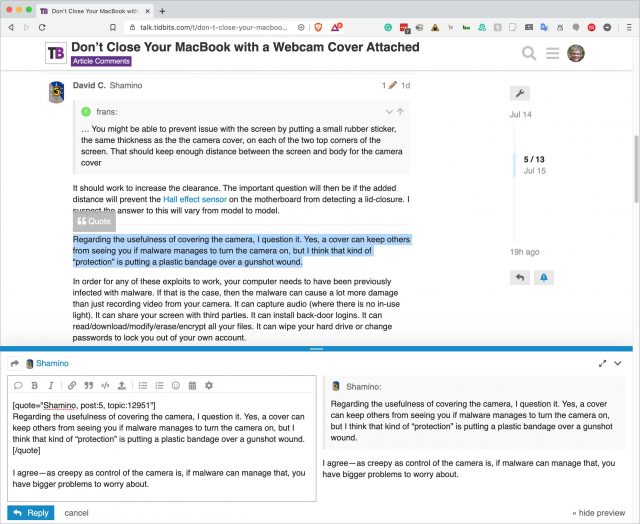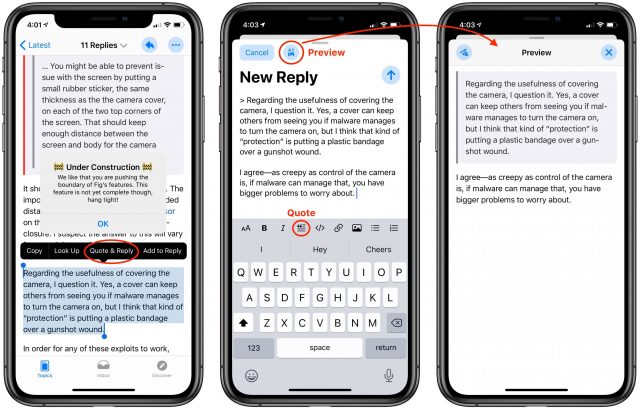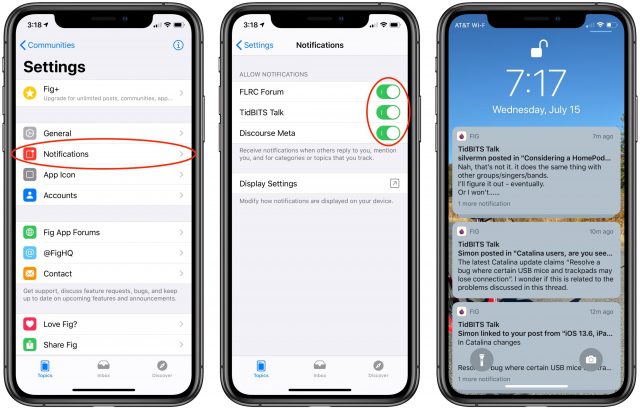#1523: Apple launches symptom tracking and Car Keys, five iOS apps for homeschooling, Fig gives Discourse iOS push notifications
Apple updated all of its operating systems last week, adding the Car Keys feature to iOS 13.6, symptom tracking to the Health app, and more News features to iOS 13.6, iPadOS 13.6, and macOS 10.15.6 Catalina. As the COVID-19 pandemic continues to rage on, many parents are considering alternatives to sending their kids back to school in the coming year. With a year of homeschooling under his belt, Josh Centers suggests five education apps that might help young children. Wrapping up the issue, Adam Engst reviews Fig, a free iOS app that provides a native interface and push notifications for Discourse, the discussion forum software that powers our article comments and TidBITS Talk, along with thousands of other online communities. Notable Mac app releases this week include Security Update 2020-004 (Mojave and High Sierra), Safari 13.1.2, Microsoft Office for Mac 16.39, Ulysses 20, PDFpen and PDFpenPro 12.1.2, CleanMyMac X 4.6.9, Pixelmator Pro 1.7, BBEdit 13.1.2, and Luminar 4.3.
iOS 13.6, iPadOS 13.6, macOS 10.15.6, watchOS 6.2.8, and tvOS 13.4.8 Add News Features, Car Keys, Symptom Tracking
Apple has broken up the summer doldrums with iOS 13.6, iPadOS 13.6, macOS 10.15.6, watchOS 6.2.8, and tvOS 13.4.8. These are almost certainly the last feature releases before iOS 14, macOS 11 Big Sur, and the rest hit the scene later this year.
Surprisingly, given how late in the cycle they come for Apple’s current operating system releases, these updates offer not only the usual “bug fixes and improvements,” but also some notable new features, such as the Car Keys feature advertised for iOS 14 and new options in Apple News.
As always, the question is when you should install these updates. Unless you’ve just bought a BMW that rolled off the line in the last two weeks or are an Apple News zealot, we recommend the usual caution. Wait a few days to make sure nothing new crops up and then install.
Car Keys
This addition comes as a bit of a surprise since Apple advertised it for iOS 14, but Car Keys has arrived in iOS 13.6 and watchOS 6.2.8. The feature lets you use your recent iPhone or Apple Watch Series 5 as the key for your car, enabling you to unlock and start your car, even up to 5 hours after your iPhone battery runs down. You can also share car keys with others and restrict what those other users can do, including limiting the stereo controls and top speed. As one might want to do for a teenage driver.
Sounds fantastic, right? The bad news is that the car must have the necessary NFC hardware baked-in. So far, the only manufacturer to support it is BMW, which says it’s adding the feature to numerous models manufactured after 1 July 2020—you can check to see if your car is compatible via the vehicle tab in the BMW Connected app.
What’s New in Apple News
Almost no one can use Car Keys right now, but many more people—125 million according to Apple—might appreciate the four new features these releases add to Apple News:
- Personalized Apple News email newsletters: You can now have personalized Apple News emails sent to you daily. To sign up on the iPhone, go to Following > Notifications & Email > Apple News Newsletter and tap Sign Me Up. On an iPad, Notification & Email is at the bottom of the sidebar, and on a Mac, choose File > Manage Notifications & Email.
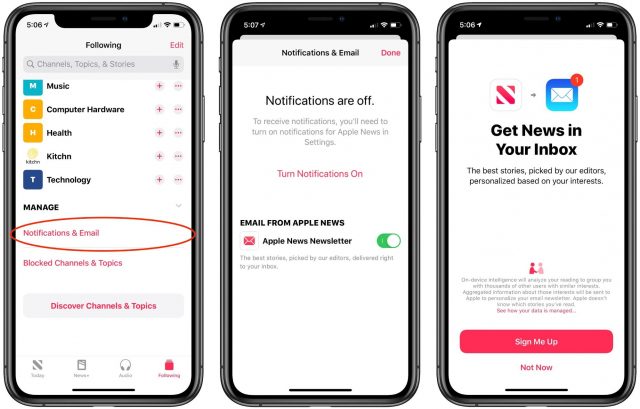
- Local news: Apple News now has a new local news section for select cities, including San Francisco, the Bay Area, Los Angeles, Houston, and New York City. Plus, Apple News is adding more local and regional news outlets, including The Charlotte Observer, the Miami Herald, and The News & Observer from Raleigh, North Carolina.
- Apple News+ Audio Stories: Subscribers to Apple News+ now have access to new audio versions of written stories from Apple News+ sources, narrated by professional voice actors. Apple mentioned this feature only in relation to the iOS 13.6 update, and not in the release notes for iPadOS 13.6 or macOS 10.15.6.
- Apple News Today: Apple has also started a new news roundup podcast, called Apple News Today, which will be available to US listeners every weekday morning in Apple News (look in the Audio tab) and on Apple Podcasts.

We’re not sure how popular any of these features will be. Still, Apple investing so much effort in news is notable, especially the Apple News Today podcast, which is the company’s first foray into creating a news program itself, even if it draws its content from articles on Apple News.
Tracking Symptoms in Health
The Health app in iOS 13.6 has an entirely new category of biometrics: symptoms. To see these, tap the Browse tab in Health and then tap Symptoms. You can track things like body aches, runny nose, coughing, sore throat, wheezing, vomiting, loss of smell, and fever.
Apple undoubtedly added this feature in response to the COVID-19 pandemic, but it includes a broad list of symptoms that fall outside those typically exhibited with COVID-19. It could be a real help in tracking the progression of any illness.
Everything Else in iOS 13.6 and iPadOS 13.6
If you’re tired of Apple forcing you to download updates that take up space on your devices, even if you weren’t ready to install them, you can now turn that off. Both iOS 13.6 and iPadOS 13.6 include a new setting to control if system updates automatically download to your device while connected to Wi-Fi. You can find that switch in Settings > General > Software Update > Customize Automatic Updates.
The updates also fix a number of bugs. This first list of fixes applies to both iOS 13.6 and iPadOS 13.6, which:
- Address a bug that could cause apps to become unresponsive when syncing data from iCloud Drive
- Address a bug that could interrupt audio when using Wi-Fi Calling
- Resolve a bug that could cause the software keyboard to appear unexpectedly when connected to certain third-party hardware keyboards
- Fix a bug that could cause Japanese hardware keyboards to be incorrectly mapped as a US keyboard
- Address stability issues when accessing Control Center when Assistive Touch was enabled
- Provide a mechanism for administrators to specify domains to exclude from traffic carried by always-on VPN connections
A few problems are specific to iOS 13.6, which:
- Fixes a bug that could cause data roaming to appear to be disabled on eSIM even though it remained active
- Fixes a bug that caused some phone calls from Saskatchewan to appear as originating from the United States
- Fixes a bug that prevented some iPhone 6S and iPhone SE devices from registering for Wi-Fi Calling
The updates block 26 security vulnerabilities.
You can install the updates, which clock in at 387.3 MB on an iPhone 11 and 349.9 MB on an iPad Air, in General > Software Update.
Other Changes in macOS 10.15.6 Catalina
macOS 10.15.6 Catalina receives the new Apple News features, along with some changes that:
- Add a new option to optimize video streaming on HDR-compatible Mac notebooks for improved battery life
- Fix a bug that could cause the computer name to change after installing a software update
- Resolve a bug where certain USB mice and trackpads may lose connection
As with previous updates to Catalina, Apple said nothing about fixes for problems users have experienced with Mail. However, the most recent comment in Michael Tsai’s long-running thread warning about data loss notes that Mail’s build number has changed, so it’s possible that Apple made some changes.
You can install the 2.96 GB macOS 10.15.6 update in System Preferences > Software Update.
macOS 10.15.6 includes fixes for 16 security vulnerabilities.
watchOS 6.2.8
The watchOS 6.2.8 update adds Car Keys support to the Apple Watch and makes it so users in Bahrain, Brazil, and South Africa now have support for the ECG app and irregular heart rhythm notifications.
You can install the update, which weighs in at 118 MB on an Apple Watch Series 5, from the iPhone’s Watch app: go to Watch > General > Software Update.
watchOS 6.2.8 eliminates 16 security vulnerabilities.
tvOS 13.4.8
As usual, the tvOS 13.4.8 update notes are sparse, promising only “general performance and stability improvements.” The update includes 17 security fixes, largely shared with the other operating systems.
If automatic updates aren’t on, you can update your Apple TV HD or Apple TV 4K by going to Settings > System > Software Updates. We just let ours update automatically when they get around to it. Let us know if you notice any changes.
Five Homeschooling Apps for Young Children
Even as the COVID-19 pandemic rages on, many schools are preparing to open, some no matter what. But many parents and teachers don’t think school reopenings in their areas are safe. A USA Today poll found that one in five teachers don’t plan to return to school this year, and a whopping 60% of parents are considering homeschooling.
Anecdotally, I’ve seen fellow parents asking online for help on how to get started. When my oldest son was due to enter kindergarten last year, my wife and I decided instead to homeschool him, so I’ve been trying to advise new homeschoolers as best as I can, based on my experience over that time. I also wrote a quick guide at The Prepared on how to get started homeschooling, urging those considering it to start now, because time is running out. Why is that?
School registrations have already begun, and the school year will start soon. You need to register for whatever homeschool option you decide on, and you need to acquire the requisite curricula and figure out how to use them. In truth, it’s a bit late to be getting started now, but these are unusual times.
While my wife—who teaches at the local high school—and I are very much old-fashioned textbook people when it comes to the curricula we invest in, we’ve found that iPhone and iPad apps can offer educational value as well. I hesitated to bring the iPad into the mix because many tech leaders severely limit the technology their kids use. Even Steve Jobs didn’t let his kids use iPads (which makes you wonder what he knew that we don’t).
But the reality is, while we try to limit screen time, our kids are growing up in a technological world, and they need to be familiar with that technology. Plus, these apps can sometimes give both kids and parents a welcome break from each other. (We’ve barely left the house in over four months, so we’ll take whatever breaks we can get.)
If you or someone you know is going to be in the position of homeschooling young children this year, here are five apps we’ve found useful.
TeachMe (iPhone and iPad, $0.99–$7.99)
The TeachMe games, which are available for preschoolers through third-graders, are some of my son’s favorites. He calls TeachMe Kindergarten “the mouse game,” because the app guides him with a cartoon mouse. Most cost $1.99, with no subscriptions or other nonsense. The preschool app is only $0.99, or you can buy the entire bundle for $7.99.
You have to set up an on-device profile for your child, but the TeachMe apps don’t require an online account.
The TeachMe apps work on the iPhone and iPad, but our son plays them almost exclusively on the iPad, preferably with an Apple Pencil or some other stylus to help with the writing exercises.
Most of our experience is with TeachMe Kindergarten, but the apps offer a grab bag of subjects: spelling, math, letter writing, and more, presenting children with a random series of age-appropriate challenges. As they progress, they receive little rewards like coins, stars, and levels, and the app guides them along with a friendly voice.
Duolingo ABC (iPhone and iPad, Free)
Duolingo is a great app that we covered all the way back in “FunBITS: Duolingo Makes Learning Languages Enjoyable” (14 June 2013). The company now offers a version for kids learning to read: Duolingo ABC. An online account is not required.
Just as with the main Duolingo app, Duolingo ABC teaches through fun, colorful games. Activities include dragging letters into the right order in a word, listening to and repeating letter sounds (with voice recognition), and tapping objects whose names start with the specified letter.
Orboot Globe (iPhone and iPad, $55)
This globe and app combination is a new addition to our toolbox. The Orboot Globe is pricey at $55, but we caught it on sale for $35 and were sold by its cute promotional video. It was an instant hit at our house.
As a globe, the Orboot Globe is pretty much what you’d expect. What makes it stand out is that kids use the free Orboot Earth AR app to scan locations on the globe to learn more about them.
Kids line up a star on the globe with one that appears in the camera’s viewfinder, causing 3D objects to pop up. They can switch among viewing facts about animals, culture, monuments, cuisine, and more—all specific to the scanned spot. Kids can then tap an object on the screen to learn more about it. The package also includes a passport that you can stamp as your kids explore different countries.
The company also makes Orboot Dino AR, which kids can use with the globe to learn about dinosaurs. The Orboot apps don’t require an online account, but they push you to set one up.
Beware that you need some serious system resources for the Orboot apps. Orboot Earth AR took up nearly 2 GB of storage on my iPhone once fully loaded, and its AR functionality makes it CPU and battery intensive as well.
Prodigy: Kids Math Game (iPhone and iPad, Free)
Prodigy is a math training app in the guise of a role-playing game. As in many such games, kids move from battle to battle, casting spells and using other abilities to fight monsters.
Here’s the twist: to cast a “spell,” kids have to answer math questions.
The Prodigy app is free, but you must sign up for an online account. It theoretically allows you to login using a Google account, but when I tried that, the game loaded in Safari instead of in the Prodigy app, so I had to create a new account.
As an adult, I’m unimpressed with the rough graphics, and overall, I find the app janky. But my son loves playing it, and it strengthens his math skills, which is what matters.
Letter Tiles for Learning (iPad, $19.99)
My son has a hard time reading, so we’ve tried several reading curricula in an attempt to find something that works for him—this is a common struggle in the homeschooling world. Thankfully, my wife is a teacher, so she spent weeks researching reading programs to figure out what might work.
She eventually settled on All About Reading, which is based on the Orton-Gillingham method. The method was developed by neuropsychiatrist Samuel Torrey Orton and educator and psychologist Anna Gillingham in the 1930s specifically to address the needs of children with reading difficulties.
We’ve barely dipped our toes into the method, but the results have been promising so far. If you know a child who is having difficulty reading, it might be worth looking into.
The Letter Tiles for Learning app is designed to accompany the All About Reading curriculum, but you could conceivably use it on its own. There are letter layouts for each lesson, and kids can use the provided tiles to construct words. They can press and hold a letter to change its case or hear the sounds it makes. The app is a little pricey, but homeschool curricula aren’t cheap.
And Back to You…
These apps are just a few suggestions that we have found helpful in our homeschooling efforts. If you or a loved one is jumping into homeschooling this year, note that flexibility is the name of the game. Different things will work for different children, and you can’t get too invested in a particular tool. But one of the great things about homeschooling is that if something isn’t working, you can experiment with alternatives that might work better for your children. Ideally, that would happen in public schools as well, but all too often, teachers have a single curriculum that they have to apply to an entire class, even when it doesn’t work for a particular child.
Just remember to relax, try to have fun with homeschooling, and don’t beat yourself up. You’re going to have good days and bad days, strong subjects and weak subjects. The key is to be flexible and keep trying different approaches until you find what works best for your children.
If you can recommend any other good educational apps for kids, we’d love to hear about them in the comments!
Fig Brings iOS Push Notifications to Discourse Forums
We rely on the Discourse discussion system for comments on TidBITS articles and for the TidBITS Talk discussions. Discourse has become popular over the past decade, and it’s used by an ever-increasing number of sites, including (to name a few you may recognize) the note-taking app Agenda (which integrates its forum within the app), the Chrome-derived browser Brave, the information management app DEVONthink, the must-have automation utility Keyboard Maestro, camera-maker Wyze, and virtual fitness company Zwift.
At the start of the year, I also set up a Discourse forum for the local Finger Lakes Runners Club to replace a crufty decades-old mailing list run in Mailman. One of my goals in switching to Discourse was to provide a self-hosted alternative to a variety of Facebook groups that were fragmenting the local running community. I consider Facebook to be a cancerous growth on the global Internet, and I wanted to ensure that the club’s discussion forum wouldn’t end up at the mercy of a soulless and ethically bankrupt megacorp.
But Facebook does one thing notably better than Discourse—its mobile apps provide push notifications, which was often helpful for coordination when people were a little late to a group run, for instance. Although Discourse uses a responsive Web design that degrades to small mobile screens well and even offers iOS and Android apps, those apps are basically Web views and don’t support push notifications for self-hosted sites. (I don’t begrudge Discourse’s developer, Civilized Discourse Construction Kit, the fees for hosted sites that do get push notifications, but when comparing $100 per month for a hosted site to the $12 per month we pay for our installation on Digital Ocean, I have to go with the self-hosted option.)
I hadn’t realized the notification limitation when I installed Discourse for the club, so I was quite pleased when I recently learned about Fig, a new iOS app that offers its own interface for Discourse and provides full notification support. Fig boasts native iPhone and iPad interfaces, helps you find new Discourse-based communities, and brings all your Discourse discussions into a single spot.
Fig is free with in-app purchases that largely amount to supporting the app. With them, you get unlimited communities, unlimited posts, access to private communities, and free alternative app icons, but I haven’t yet run into any of the limitations that would require the $14.99 per year subscription. The big win for the subscription is probably access to private Discourse communities.
On an iPad, Fig provides full multitasking support, so you can open Discourse in Slide Over, where it takes on the iPhone look. Or you can use it in Split View, either with another app or with multiple Fig views such that you can easily refer to a topic in one view while composing in another.
With two forums where I have to read every message (TidBITS Talk and FLRC), I don’t have extra time to look for or participate in many more Discourse communities. Nonetheless, in its Discover screen, Fig catalogs over 7500 forums on a wide variety of topics, including arts and entertainment, development languages, education, finance and cryptocurrency, makers, and numerous products. And yes, you can find TidBITS Talk there.
Subscribing to a forum—which means adding it to the list of communities that Fig tracks—is as simple as tapping Subscribe while previewing the forum or tapping the + button next to its name in a search. If you want to add a forum directly, there’s a + button in the Topics screen that lets you enter the URL for any Discourse-based community. If you accidentally add a forum you don’t want to keep around, press and hold on its name in the Communities list on the Topics screen to bring up controls for moving (within the list) or deleting the forum.
All changes you make are synced to your other devices running Fig, presumably through iCloud, since you don’t need a special account for Fig itself.
For browsing forums that you haven’t joined yet, start at the Topics screen. It starts with a list of Communities—the forums to which you’ve subscribed in Fig—and a tap on one displays its main screen, which is likely either the latest topics or a list of categories. You can view the forum by those, or by top topics, new topics, unread topics, or bookmarks by tapping the View By button.
One tip that you might find useful: pull down on any topics list to reveal a search field that lets you search across all posts in the forum.
Regardless, once you tap a topic title, you see the full discussion, either in the main pane on the iPad or taking over the screen on an iPhone. Fig even shows Discourse’s familiar blue dots to indicate the number of unread posts in a topic and properly scrolls you to unread posts in a topic if you’ve visited before.
To collect all your Discourse-based discussions into one place, Fig provides the Inbox screen, which works much like the Inbox in Mail. Each forum that you’re logged into gets its own inbox, so you can focus on what’s new there, or you can use All Inboxes to see what’s new across all your communities. What appears here is up to you—the inboxes show your notifications much like the menu that appears when you click your avatar in the upper-right corner of any Discourse forum’s Web interface. More on notifications in a bit.
Once you’re reading posts in a topic, things work pretty much as you’d expect from Discourse. You have infinite scrolling through all the posts, with more loading at the bottom as necessary. Fig displays who has replied to what and when, and you can like (with the heart button), bookmark, share, or reply to a post with buttons at the bottom of each one. A ••• button provides access to hidden toolbar buttons and notification controls, and for those of us who are admins, the capability to edit or delete posts.
The only place I’ve found that Fig falls down somewhat is in its post composer. To be fair, Discourse’s native Web composer is brilliant, making it easy to quote small bits from previous posts merely by selecting them and clicking a Quote button that appears nearby, and offering clean, Markdown-based styling of text. It even provides a live preview off to the right, which is especially helpful when you insert links (which get summary “oneboxes”), images, and special things like custom date ranges and polls.
Fig makes a valiant effort at supporting everything Discourse can do, but most notably, when you select text and tap a Quote & Reply button, you get a dialog telling you the feature is under construction. Luckily, it’s not a complete deal-breaker because you can always copy the text instead, start your reply, and use the Quote button (or just type >) before pasting the text to quote it. There is no live preview, even on the iPad, but you can always tap the Preview button to see what your post will look like.
Everything I’ve said so far supports the contention that Fig is a full-featured Discourse client for the iPhone and iPad. But since the free DiscourseHub app for iPhone does much of the same, including the Quote button when composing, what about Fig’s raison d’ être: push notifications?
Put bluntly, they just work, thanks to Fig being a native app. In the Topics screen, tap the gear icon at the top to bring up Fig’s Settings screen, and then tap Notifications. For each of your logged-in forums, you can enable or disable notifications. When they’re enabled, Fig displays notifications with brief excerpts, just like any other app, and if you want, they can even flow through to your Apple Watch. Tapping one opens it in Fig, as you’d expect.
That does raise the question of exactly what Fig will notify you of. The short answer is that Fig simply passes Discourse’s notifications off to the system-wide iOS notification system. For a more complete answer, you need to understand how Discourse notifications work. For every category or topic, you can choose (click the bell icon at the top for a category or at the bottom for a topic) from four notification levels:
- Watching: You’re notified of all new posts.
- Watching First Post: You’re notified of the first post in every new topic.
- Tracking: You’re notified if someone mentions your @name or replies to one of your posts.
- Normal: For the purposes of Fig notifications, Normal is effectively the same as Tracking.
It can get more complicated. If you reply to a post, you’re automatically set to Tracking for its topic. And, of course, if someone sends you a private message, Discourse notifies you of that too. Happily, the default end result is usually what you want. If it’s not, you can tweak all the settings in the Notifications screen of any Discourse forum’s preferences.
To summarize then, given that it has to compete with Discourse’s own Web-based apps, Fig does a good job of providing features that go above and beyond replicating the browser experience. They include:
- A native iOS/iPadOS user experience with support for multitasking and dynamic type
- A browsable, searchable catalog of thousands of Discourse communities
- Push notifications for anything that generates a Discourse notification
- A unified inbox that brings together all your notifications from multiple forums
- Nearly full-fledged support for composing message content, with improvements coming
Fig is essential for anyone who wants push notifications on their iPhone or iPad—nothing else can provide that. It’s also worthwhile for anyone who wants an elegant interface for participating in multiple Discourse forums from a mobile device. And it’s free, so it’s easy to give it a try and see if it fits into your preferred strategy for participating in online conversations.

